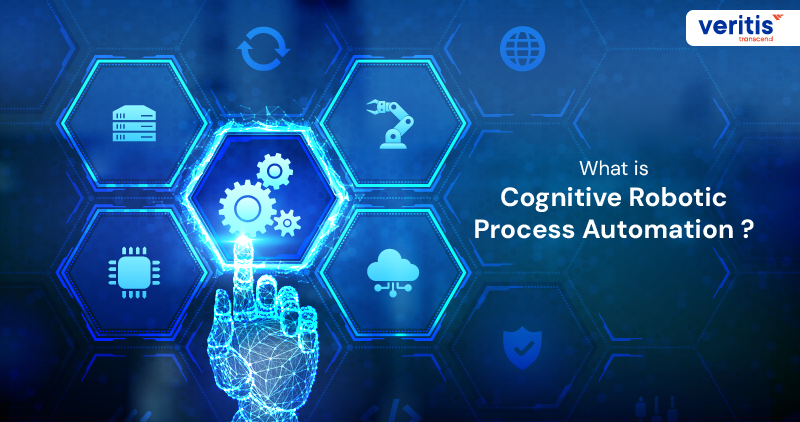
Over the last decade, Robotic Process Automation (RPA) has become a staple in enterprise automation strategies. It excelled at removing manual effort from repetitive, rule based workflows, such as processing invoices, extracting structured data, or executing routine IT tasks. However, as business processes became more complex, involving unstructured information, contextual decision making, and dynamic rules, the limitations of RPA became apparent.
Cognitive Robotic Process Automation (CRPA) evolved to bridge this gap. By integrating RPA with Machine Learning (ML), Natural Language Processing (NLP), and Computer Vision, cognitive RPA enables automation systems to “think,” “learn,” and “adapt” rather than simply “follow instructions.” As a form of intelligent process automation (IPA) solutions, CRPA can handle decision driven processes and transform business operations at scale.
Gartner identifies cognitive robotic process automation as a key component of the hyper automation strategy, noting that organisations adopting cognitive automation solutions achieve greater scalability, higher ROI, and improved resilience compared to those relying solely on RPA. By embedding cognitive automation solutions into enterprise workflows, robotic process automation benefits for businesses can explore the full potential of cognitive RPA as part of a broader intelligent automation strategy.
From RPA to CRPA: The Evolution of Automation
Traditional RPA excels at structured, repetitive tasks. Your finance team uses it for invoice processing. HR deploys it for employee onboarding workflows. These implementations deliver measurable ROI, typically resulting in a 25 to 40% cost reduction in targeted processes, according to research.
But here’s what every executive discovers: RPA hits a ceiling. When processes involve exception handling, document interpretation, or contextual decision making, traditional bots break down. You end up with automation islands rather than intelligent automation that scales across the enterprise.
Cognitive Robotic Process Automation (CRPA) overcomes these limitations by augmenting your automation foundation with AI powered decision making capabilities. Instead of following rigid if then rules, cognitive RPA bots can interpret context, learn from patterns, and make informed decisions within defined parameters. By leveraging cognitive automation solutions, enterprises can transition from isolated process automation to adaptive, complete intelligent automation ecosystems.
Organizations adopting cognitive robotic process automation also benefit from enterprise wide cognitive automation services, including assessment and use case mapping, as well as deployment and optimization. These cognitive automation services integrate Machine Learning (ML), Natural Language Processing (NLP), and Computer Vision into daily operations, delivering sustainable ROI.
By embedding cognitive automation solutions into their technology stack, workflow automation for enterprises moves beyond traditional RPA to a scalable, resilient, and intelligent automation strategy that drives growth, compliance, and operational agility.
What Makes CRPA “Cognitive”?
The cognitive element comes from embedding AI capabilities into automation workflows. These capabilities enable CRPA to process both structured and unstructured data, understand the context, and make informed decisions in real time. Here are AI capabilities that power CRPA
1) Natural Language Processing (NLP)
- Reads and interprets human language from emails, chat logs, contracts, and customer feedback.
- Allows bots to interact with customers in natural language, improving service experiences.
2) Machine Learning (ML)
- Analyses historical data to improve predictions and recommendations over time.
- Allows bots to adapt to new patterns without manual reprogramming.
3) Computer Vision
- Recognises and processes visual inputs such as scanned documents, identity proofs, or medical imaging.
- Widely used in banking for KYC verification and in healthcare for diagnostic automation.
How is Cognitive RPA Redefining Business Performance?
Gartner estimates that cognitive automation in business process management will drive $2.3 trillion in business value globally by 2030. Organizations implementing CRPA report average productivity gains of 40 to 60% in targeted processes, compared to 15 to 25% from traditional RPA.
The math is compelling:
- Process Completion Rates: 85 to 90% straight through processing vs 40 to 50% with traditional RPA
- Error Reduction: 90% fewer processing errors compared to manual operations
- Decision Speed: 70% faster resolution times for complex scenarios
- Cost Reduction: 50 to 70% lower operational costs in cognitive enabled processes
But the real value lies in capability expansion. CRPA enables automation of processes that generate revenue, not reduce costs.
Useful Link: What is Cognitive Automation?
Key Business Benefits of CRPA
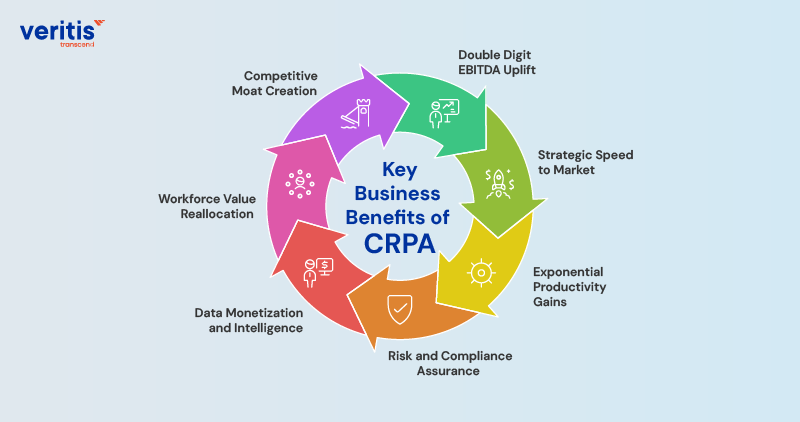
1) Double Digit EBITDA Uplift
- Proven to deliver 3 to 5% EBITDA improvement within the first fiscal year
- 30 to 60% cost takeout on targeted processes without sacrificing quality
2) Strategic Speed to Market
- Cycle time compression of 70 to 90% on core business workflows
- Faster product launches, M&A integration, and market entry
3) Exponential Productivity Gains
- 2 to 4x increase in process throughput without adding headcount
- 24/7 operational continuity with no degradation in quality
4) Risk and Compliance Assurance
- 99.9% accuracy on high stakes, regulated workflows
- Compliance incidents reduced by up to 90% through AI driven anomaly detection
5) Data Monetization and Intelligence
- Converts operational data into predictive and prescriptive insights
- Informs executive decision making with real time business intelligence loops
6) Workforce Value Reallocation
- Frees 20 to 40% of FTE capacity for strategic growth initiatives
- Shifts talent focus from repetitive execution to innovation and customer engagement
7) Competitive Moat Creation
- Creates hard to replicate process efficiencies and AI enabled service models
- Positions the enterprise automation solutions for sustained market leadership
Differences Between Traditional RPA vs Cognitive Automation
| Dimension | Traditional RPA | CRPA (Cognitive RPA) |
| Core Capability | Automates rule based, repetitive tasks using structured data | Automates end to end, decision based workflows using structured + unstructured data |
| Intelligence Layer | No AI, requires explicit rules for every variation | Integrates AI, ML, NLP, and computer vision for adaptive decision making |
| Process Scope | Works well for stable, predictable processes | Handles dynamic, exception heavy, and judgment based processes |
| Data Handling | Structured data only (e.g., spreadsheets, databases) | Multi format data (emails, PDFs, images, voice, chat) |
| Scalability | Scales task by task, requiring heavy IT intervention | Enterprise scale orchestration with minimal manual intervention |
| Error Handling | Stops on exceptions; needs human intervention | Learns from exceptions; self heals and adapts over time |
| ROI Profile | Cost savings of 10 to 30%, ROI in 12 to 18 months | Cost savings of 30 to 60%, plus revenue enablement, ROI in 6 to 9 months |
| Business Value | Efficiency gains in isolated functions | Strategic transformation across operations, compliance, and customer experience |
| Workforce Impact | Primarily reduces manual effort in back office | Reallocates talent to innovation, growth, and strategic initiatives |
The Automation Maturity Gap
Here’s where most executives underestimate the opportunity. Traditional RPA addresses approximately 20% of enterprise processes, specifically the simple and structured ones. CRPA expands this to 70 to 80% by handling:
- Unstructured document processing
- Exception based decision making
- Multi channel customer interactions
- Complex data analysis and pattern recognition
- Predictive process optimization with AI
A recent Forrester study found that organizations using cognitive automation achieve an average annual benefit of $13.2 million within three years of implementation.
From Efficiency to Intelligence: The ROI Transformation
Traditional RPA ROI Profile
- Implementation Cost: $50,000 to $150,000 per bot
- Payback Period: 6 to 12 months
- Value Source: Labor cost reduction
- Typical ROI: 200 to 300% over 3 years
Cognitive RPA ROI Profile
- Implementation Cost: $200,000 to $500,000 per use case
- Payback Period: 8 to 18 months
- Value Source: Revenue enablement + cost reduction + decision intelligence
- Typical ROI: 400 to 600% over 3 years
The higher investment requirement reflects sophisticated AI capabilities, but the return multiple justifies the commitment.
Useful Link: Cognitive Automation Crafting Smarter Manufacturing Solutions
Industry Use Cases and Business Outcomes
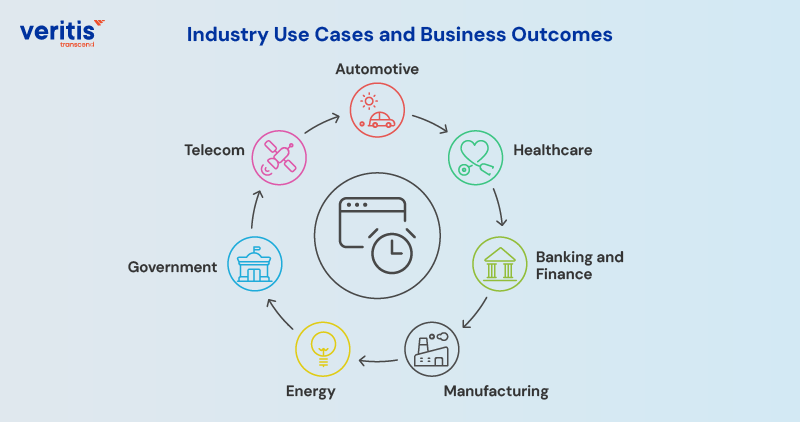
1) Automotive
- Warranty and Claims Processing: Automates multi system claims validation, reducing processing time by 70%
- Supply Chain Coordination: Real time parts tracking across OEMs, suppliers, and dealers
- Use Case: Intelligent warranty claim adjudication integrating IoT telematics data from vehicles
- Impact: Fraud reduction by up to 25%, claim cycle cut from 14 days to 2 days, $15 to 20M annual savings for large OEMs
- Strategic Value: Improves brand trust, accelerates dealer reimbursements, optimizes after sales revenue
- Benefits: Lower warranty fraud, faster customer reimbursement, improved inventory turns
2) Healthcare
- Claims and Eligibility Verification: Reduces insurance claim processing from days to minutes
- Clinical Data Processing: Extracts insights from unstructured patient records for faster diagnosis support
- Use Case: AI driven medical coding and automated claims processing across insurers
- Impact: 99.8% accuracy, $8 to 12M/year admin savings, patient discharge accelerated by 20 to 30%
- Strategic Value: Frees clinical staff from paperwork, speeds patient turnover, boosts satisfaction scores
- Benefits: 99%+ accuracy in compliance heavy workflows, improved patient throughput, reduced admin cost by 30 to 40%
3) Banking and Financial Services
- Loan Origination and KYC: Automates identity verification, credit checks, and documentation in under an hour
- Fraud Detection: Uses AI to spot anomalies in real time transactions
- Use Case: Automated KYC/AML checks with NLP based document reading and cross database fraud screening
- Impact: Onboarding time reduced from 5 days to 30 minutes, compliance breaches reduced by 80%, $25M/year in retained revenue
- Strategic Value: Enables same day account opening and loan approvals, enhancing competitive positioning
- Benefits: Accelerated revenue capture, reduced compliance risk, 24/7 onboarding capability
4) Manufacturing
- Procure to Pay Automation: Automates supplier invoice matching and payment approval
- Predictive Maintenance: Integrates IoT data into maintenance scheduling
- Use Case: Predictive maintenance scheduling using IoT + CRPA integration
- Impact: Downtime reduction by 40%, maintenance cost savings of $10–15M annually, and inventory optimization by 15%
- Strategic Value: Extends asset life, supports just in time manufacturing, and reduces capital tied up in spares
- Benefits: 40% reduction in downtime, improved supplier relationship management, leaner inventory management
5) Energy
- Meter to Cash Operations: Automates billing, payment posting, and exception handling
- Regulatory Reporting: Extracts and validates operational data for compliance submissions
- Use Case: Automated meter to cash cycle with anomaly detection for billing accuracy
- Impact: Revenue leakage reduced by 12 to 18%, OpEx savings of $20M+, billing disputes cut in half
- Strategic Value: Improves cash flow predictability, supports dynamic pricing strategies
- Benefits: Reduced revenue leakage, faster compliance cycles, 30%+ OpEx savings in back office functions
6) Government
- Citizen Service Portals: Automate permit issuance, license renewals, and benefits processing
- Case Management: Consolidates multi agency data for faster approvals
- Use Case: End to end permit/license issuance automation with multi agency data orchestration
- Impact: Processing time cut from weeks to 2 to 3 days, citizen satisfaction up by 35%, operational savings of $50M+ in large programs
- Strategic Value: Demonstrates public service modernization, increases transparency, and reduces backlog liabilities
- Benefits: Reduced processing backlogs, improved service delivery, better compliance tracking
7) Telecom
- Order to Activation: Automates new service provisioning and contract validation
- Network Operations: Uses AI to predict faults and initiate self healing workflows
- Use Case: Zero touch service provisioning and predictive network fault resolution
- Impact: Service activation time cut by 50–70%, churn reduced by 8–12%, $30M annual savings in automation in enterprise operations
- Strategic Value: Improves SLA compliance, enhances customer loyalty, and opens up sales opportunities for premium services
- Benefits: 50%+ faster service activation, improved SLA compliance, reduced churn through proactive issue resolution
The Strategic Value Multiplier Effect
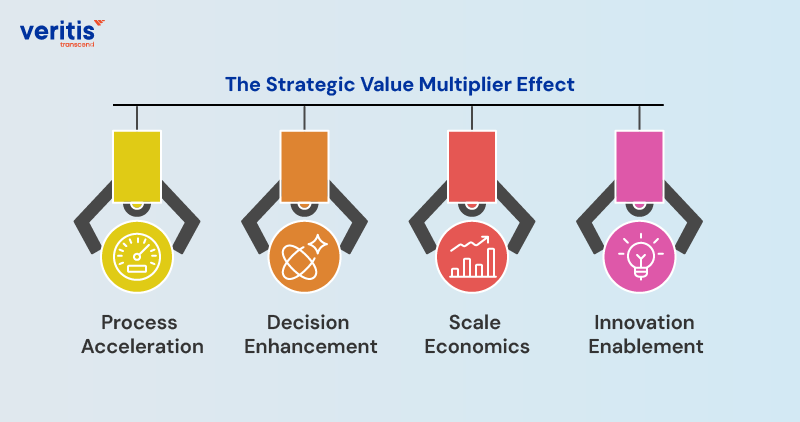
CRPA delivers value through four distinct mechanisms that compound over time:
1) Process Acceleration (Immediate Value)
- 70% faster cycle times for complex processes
- 85% reduction in manual handoffs
- 60% improvement in first pass accuracy
2) Decision Enhancement (6 Month Value)
- AI-powered RPA solutions insights drive better business decisions
- Predictive analytics prevent issues before they occur
- Real time optimization adjusts processes automatically
3) Scale Economics (12 Month Value)
- Cognitive capabilities improve with more data
- Cross process learning accelerates additional implementations
- Platform effects reduce the marginal costs of new use cases
4) Innovation Enablement (18+ Month Value)
- New business models become feasible
- Customer experiences previously impossible to deliver
- Competitive advantages through superior operational intelligence
Cost Benefit Analysis: CRPA vs Alternatives
Option 1: Maintain Status Quo
- 3 Year Cost: Current operational expense
- Opportunity Cost: $15 to 25M in unrealized productivity gains
- Competitive Risk: High competitors gain an automation advantage
Option 2: Expand Traditional RPA
- 3 Year Investment: $2 to 4M additional RPA deployment
- Expected Return: $6 to 8M in cost savings
- Limitation: Plateau effect limits long term value
Option 3: Implement Cognitive RPA
- 3 Year Investment: $5 to 8M implementation and operation
- Expected Return: $20 to 35M in combined savings and revenue impact
- Strategic Benefit: Platform for continuous innovation
The investment math favors cognitive automation for organizations processing significant volumes of complex, judgment intensive workflows.
Useful Link: 7 Essential AI Tools Every CTO Should Be Familiar With
Building an Enterprise Grade CRPA Program
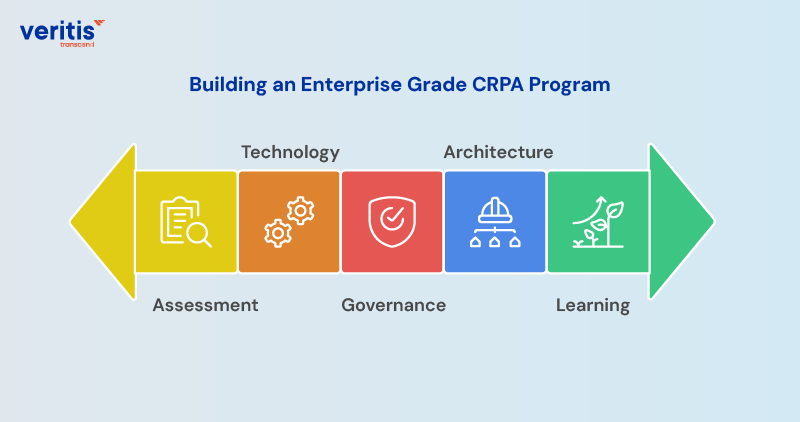
1) Assessment and Opportunity Mapping
Identify high impact processes where complexity, decision making, and unstructured data create bottlenecks. Prioritize use cases with measurable ROI potential and alignment to strategic objectives.
2) Technology Integration
Select enterprise platforms that combine AI powered RPA with orchestration, advanced analytics, and built in governance capabilities for a unified automation ecosystem.
3) Governance and Compliance by Design
Embed bias detection, explainability, audit logging, and security controls into the CRPA framework from the outset, especially critical for regulated industries.
4) Scalable Architecture
Adopt modular, API driven architectures that integrate seamlessly with ERP, CRM, legacy applications, and cloud services, ensuring enterprise broad scalability.
5) Continuous Learning and Optimization
Establish closed loop feedback mechanisms to enable cognitive automation models to improve accuracy, efficiency, and adaptability over time continuously.
CRPA and Hyperautomation
CRPA is a core enabler of hyperautomation, combining cognitive automation with process mining, advanced analytics, low code development, and orchestration tools to create fully adaptive, self optimizing business processes. According to Gartner, by 2026, 70% of large enterprises will have adopted hyperautomation frameworks, with CRPA at the center of their strategy.
Veritis’ Role in Building Intelligent Automation Ecosystems
Veritis partners with enterprises to design, implement, and scale CRPA solutions that deliver measurable business impact. Our frameworks:
- Extend existing RPA investments into more complex, high value workflows
- Integrate AI for decision intelligence and adaptive execution
- Provide built in compliance for regulated sectors
- Scale seamlessly across regions, business units, and technology platforms
We deliver complete support, from assessment and use case mapping to enterprise wide deployment and ongoing optimization, ensuring CRPA becomes a core pillar of your intelligent automation strategy for CTOs.
Conclusion
Cognitive Robotic Process Automation is all about a strategic enterprise capability that combines operational efficiency with intelligence. By uniting AI with automation, CRPA enables organizations to manage complex, data rich processes at scale, respond dynamically to changing market conditions, and meet rising compliance standards.
With Veritis’ expertise, enterprises can:
- Accelerate automation adoption
- Explore higher ROI
- Build the operational agility needed to compete, and lead in the AI powered economy.
Connect with Veritis to leverage Cognitive RPA for smarter, faster, and more impactful automation.